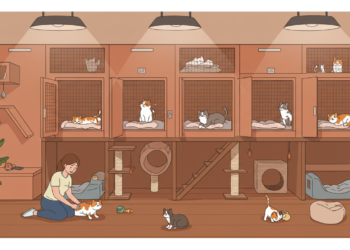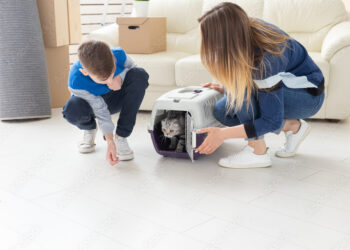Cats are amazing creatures, meowing randomly, chasing red dots, and occasionally leaving behind some kind of mess in the house. It’s no secret that cats have bossy attitudes, so if you’ve ever lived with one, you already know. Among the many kinds of mess your cat will create in the house, the most irritating one is cat litter tracking.
Whenever your cat steps outside the litter box after finishing her business, litter might get stuck in its fur and paws, and the problem of litter tracking arises. It is one of the most common problems cat parents face. If you had enough of litter tracking, then this article would be helpful to you, as we have discussed some helpful tips on how to stop cat litter tracking.
What Causes the Cat Litter Tracking?
There isn’t a single cause to explain litter tracking. Litter tracking can be caused by your cat’s habits, cat litter, the litter box’s design, how much litter you use, and how frequently you clean the litter box. There is also the possibility that your cat is hyperactive and mischievous, and thus digs a lot while using the litter box, causing it to track outside the box.
The positioning of the litter box is also important when it comes to tracking. Therefore, litter tracking can be explained by a number of factors.
8 Easy Tips To Stop Cat Litter Tracking
You can use several methods to stop litter tracks from spreading into your living room, sofa, and the rest of your house. Below we have discussed some of the most commonly used and beneficial methods to stop the tracking:
Reading Suggestions: Best Cat Breeds for Beginners: a Comprehensive Guide to Choose
Choose The Right Litter Material
Almost all types of litter leave some sort of trace outside the box; the only difference is that certain types leave a greater trace while others leave a lesser trace. Hence, when you purchase the litter material, you must buy the ones that are non-tracking litter types.

Different brands of non-clumping litter are available on the market that does not stick to the cat’s fur or paws. Likewise, these types of litter are also easily scoopable, so you can easily clean up the box once your cat has finished toileting.
Use Litter Mats
Litter mats or rugs are one of the best options to avoid litter tracking. There are several types of mats available in the market to choose from. You can place such mats in front of the litter box so that your cat can clean their paws. It is crucial that you use a large mat, as your cat might easily jump over a smaller one.
These mats are available in all shapes, sizes and with slight variations in function and durability. Do keep in mind that placing the rug is just not enough, and you have to regularly vacuum the mat to keep it clean.
Say GoodBye To The Carpet
Among all the types of flooring, having a carpet one is the worst-case scenario for cat parents with a litter tracking problem in their house. It is challenging to clean the litter from these carpets. Hence, it is advisable to roll up the carpet from the surrounding locations of the litter box. You can quickly clean other flooring areas such as laminate, hardwood, tiles, etc.
Dog Proof Cat Litter Box
Dogs are curious animals, and they do have a good sense of smell. Cat litter is something that might seem appealing to your dog, and if they try to investigate the litter box, the chances of litter tracking are very high. So it is advisable to use a dog-proof cat litter box if you have a dog at your home. There are Various dog-proof cat litter box brands available in the market. And when you buy a puppy, make one in your house by using a vacant cabinet or furniture.
Litter Box Location
The location of the litter box has a significant impact on litter tracking. If you have enough space in the house to keep the litter box in a faraway isolated place, then that would surely reduce litter tracking. You can also try placing the litter box inside a cabinet to reduce litter tracking. Do not make any sudden changes to the location of the litter box. Gradually shift the litter box location, as that will give your cat some time to adapt to the new environment.
Reconsider The Size Of Litter Box
Just like humans, cats develop new preferences as they grow. If your cat is eliminating outside the box a little too much, then it is the right time to reconsider switching the litter box. You can explore different shapes and sizes of the litter box and choose the one that might suit the preferences of your feline friend.
![]()
It is also worth considering that your cat might have outgrown the box, which is why there is so much littler tracking. The general thumb rule suggests that the litter box should be big enough that your cat can freely move inside. You can even try a covered litter box or a litter box with higher sides that would prevent the litter from coming outside.
Daily Clean Up Is Important
This might be obvious, but daily clean-up is very crucial for reducing any chances of litter tracking. Clean up the house and the litter box frequently to terminate any litter tracks. Using a vacuum might be a wise choice to get over with the clean-up quickly.
Trimming Is The Key
None of the above methods would be very fruitful if your cat has thick hair to which the litter gets stuck very quickly. It is an obvious fact that cats with longer hairs will contribute to litter tracks more frequently. To avoid this situation, you can trim your cat. This would be double beneficial, as it will reduce litter tracking and will also keep your cat’s appearance tidy.








